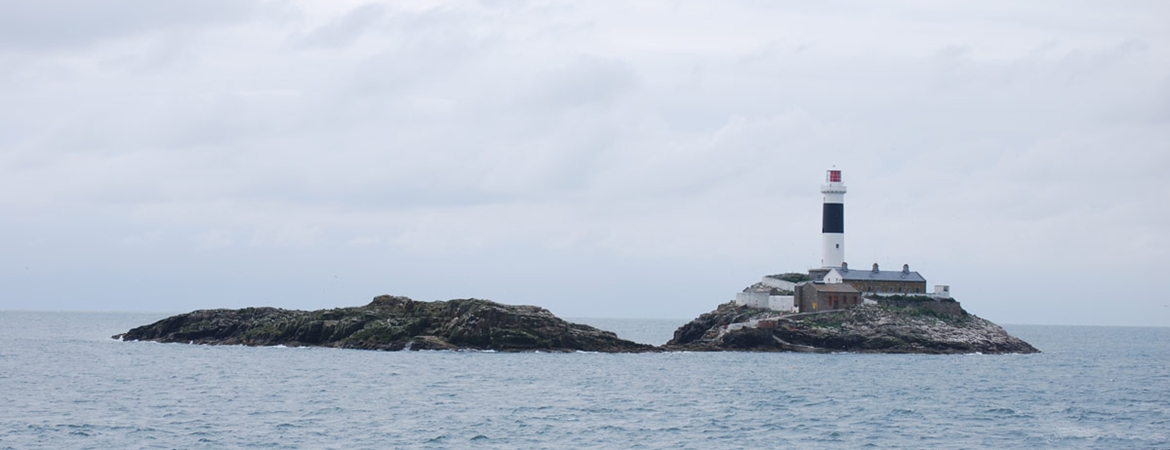Tower built on the summit of the larger and southerly of the two rocks named Rock-a-bill.
A lighthouse on Rockabill was requested by Drogheda Harbour Commissioners in October 1837. They stated that the shipping which frequented Drogheda would cheerfully pay toll towards a light on Rock-a-bill.
The Ballast Board's Inspector of Lighthouses strongly recommended it and the Board concurred, stating that there should not be any further toll beyond that which was charged for the light at Balbriggan but in January 1838 Trinity House declined to sanction the proposal.
The project remained in abeyance until August 1853, when a Trinity House Committee of Inspection, accompanied by the Deputy Master, Captain Sheppard and five Elder Brethren, appeared to favour the project. It was brought before the Board in September and was sanctioned in November.
The Ballast Board had great difficulty in finding out to whom the rock belonged and obtaining legal transfer of it to themselves.
Mr George Halpin (junior), the Ballast Board's Inspector of Works & Superintendent of Lighthouses, prepared plans in 1855 and advertised for tenders. The tender of a Mr Burgess of Limerick was accepted, the cost of the tower, 83 feet high (excluding lantern), dwellings and protecting walls being £7,119.0.0. The total cost of all the buildings, tower, walls, apparatus, etc., was £13,248.15.3.
A report from George Halpin to the Board dated 5th July 1860 stated that at sunset on 1 July the Rock-a-bill light was exhibited punctually and that its brilliance surpassed any other catoptric light on the east coast.
SUBSEQUENT DEVELOPMENTS
1872 Gas producing plant built and installed.
11/1879 Lower plates of gas holder found eaten away by corrosion, suggest they be removed and renewed. Oil lamps would have to be used in lantern.
10/1880 Gale canted over the gas holder and caused it to stick fast, thus reducing the gas pressure, and extinguishing light.
2/1882 Suggested retaining wall and new gas holder.
5/1882 Reported failure of gas holder, stated that previous repairs had nothing to do with failure.
1/1886 Estimate for repairs to gas holder and changing site to more sheltered position.
12/1886 Estimate for new gas holder instead of repairing old one.
11/1889 Estimate for new retort house, bench, coal store and meter house.
6/1890 Tenders too high, suggests work be done by Commissioners.
6/1917 Estimate for new Fog Signals, established later in year. 10/1935 Estimates for improvement of fog signal.
10/1937 Tenders received for air compressor sets.
2/1939 Over expenditure due to lowering to site of engines in old gas house and not in base of tower.
1952 Radio Telephone installed.
1955 Conversion of lens rollers to Ball bearings.
The light was converted from incandescent paraffin vapour to electric in October 1980. The Fresnel optic was replaced by an array of quartz halogen lamps in glass parabolic reflectors. The array comprises six vertical panels mounted on a turntable which revolves continuously at 2.5 RPM.
In July 1980 the diaphone fog signal was replaced by an electric fog signal with a signal of 4 blasts ever 60 seconds. The fog signal was permanently discontinued in April 2006.
In October 1980 the character was changed to Fl WR ev. 12 secs with a range of white 23 nautical miles and red 19 nautical miles. The light was converted to solar power in August 2006 and the range was reduced to white 17 nautical miles and red 13 nautical miles, with the light being exhibited in hours of darkness only.
The lighthouse was converted to automatic operation on 1 April 1989. The Lightkeepers were withdrawn and the station was put in the care of a part-time Attendant. The aids to navigation are monitored by the Service remote control and monitoring centre at Dun Laoghaire through a telemetry link.







